Berg J.M., Tymoczko J.L., Stryer L. Biochemistry
Подождите немного. Документ загружается.


remains a challenge. Other information that contributes to splice-site selection is present in DNA sequences, but it is
more loosely distributed than are the splice-site sequences themselves.
Aberrant splicing causes some forms of thalassemia, a group of hereditary anemias characterized by the defective
synthesis of hemoglobin. In one patient, a mutation of G to A 19 nucleotides away from the normal 3
splice site
of the first intron created a new 3
splice site (Figure 28.28). The resulting mRNA contains a series of codons not
normally present. The sixth codon after the splice is a stop signal for protein synthesis, and so the aberrant protein ends
prematurely. Mutations affecting splice sites have been estimated to cause 15% of all genetic diseases.
28.3.4. Splicing Consists of Two Transesterification Reactions
The splicing of nascent mRNA molecules is a complicated process. It requires the cooperation of several small RNAs
and proteins that form a large complex called a spliceosome. However, the chemistry of the splicing process is simple.
Splicing begins with the cleavage of the phosphodiester bond between the upstream exon (exon 1) and the 5
end of the
intron (Figure 28.29). The attacking group in this reaction is the 2 -hydroxyl group of an adenylate residue in the branch
site. A 2
,5 -phosphodiester bond is formed between this A residue and the 5 terminal phosphate of the intron. This
reaction is a transesterification.
Note that this adenylate residue is also joined to two other nucleotides by normal 3
,5 -phosphodiester bonds (Figure
28.30). Hence a branch is generated at this site, and a lariat intermediate is formed.
The 3
-OH terminus of exon 1 then attacks the phosphodiester bond between the intron and exon 2. Exons 1 and 2
become joined, and the intron is released in lariat form. Again, this reaction is a transesterification. Splicing is thus
accomplished by two transesterification reactions rather than by hydrolysis followed by ligation. The first reaction
generates a free 3
-hydroxyl group at the 3 end of exon 1, and the second reaction links this group to the 5 -phosphate of
exon 2. The number of phosphodiester bonds stays the same during these steps, which is crucial because it allows the
splicing reaction itself to proceed without an energy source such as ATP or GTP.
28.3.5. Small Nuclear RNAs in Spliceosomes Catalyze the Splicing of mRNA Precursors
The nucleus contains many types of small RNA molecules with fewer than 300 nucleotides, referred to as snRNAs (small
nuclear RNAs). A few of them
designated U1, U2, U4, U5, and U6 are essential for splicing mRNA precursors. The
secondary structures of these RNAs are highly conserved in organisms ranging from yeast to human beings. These RNA
molecules are associated with specific proteins to form complexes termed snRNPs (small nuclear ribonucleoprotein
particles); investigators often speak of them as "snurps." Spliceosomes are large (60S), dynamic assemblies composed of
snRNPs, other proteins called splicing factors, and the mRNA precursors being processed (Table 28.3).
In mammalian cells, splicing begins with the recognition of the 5
splice site by U1 snRNP (Figure 28.31). In fact, U1
RNA contains a highly conserved six-nucleotide sequence that base pairs to the 5
splice site of the pre-mRNA. This
binding initiates spliceosome assembly on the pre-mRNA molecule.
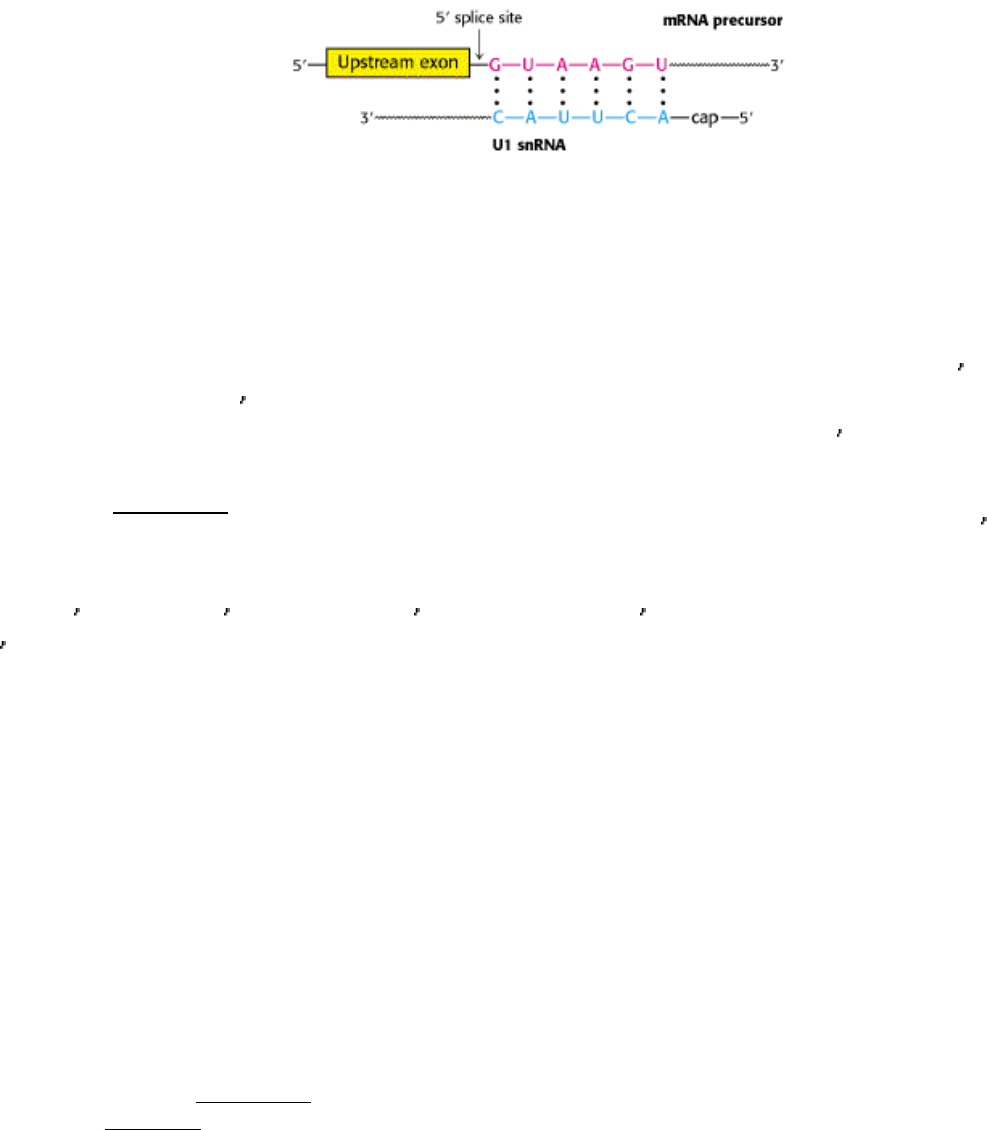
U2 snRNP then binds the branch site in the intron by base-pairing between a highly conserved sequence in U2 snRNA
and the pre-mRNA. U2 snRNP binding requires ATP hydrolysis. A preassembled U4-U5-U6 complex joins this complex
of U1, U2, and the mRNA precursor to form a complete spliceosome. This association also requires ATP hydrolysis.
A revealing view of the interplay of RNA molecules in this assembly came from examining the pattern of cross-links
formed by psoralen, a photoactivable reagent that joins neighboring pyrimidines in base-paired regions. These cross-
links suggest that splicing takes place in the following way. First, U5 interacts with exon sequences in the 5
splice site
and subsequently with the 3
exon. Next, U6 disengages from U4 and undergoes an intramolecular rearrangement that
permits base-pairing with U2 and displaces U1 from the spliceosome by interacting with the 5
end of the intron. The
U2·U6 helix is indispensable for splicing, suggesting that U2 and U6 snRNAs probably form the catalytic center of the
spliceosome (Figure 28.32). U4 serves as an inhibitor that masks U6 until the specific splice sites are aligned. These
rearrangements result in the first transesterification reaction, generating the lariat intermediate and a cleaved 5
exon.
Further rearrangements of RNA in the spliceosome facilitate the second transesterification. These rearrangements align
the free 5
exon with the 3 exon such that the 3 -hydroxyl group of the 5 exon is positioned to nucleophilically attack the
3
splice site to generate the spliced product. U2, U5, and U6 bound to the excised lariat intron are released to complete
the splicing reaction.
Many of the steps in the splicing process require ATP hydrolysis. How is the free energy associated with ATP hydrolysis
used to power splicing? To achieve the well-ordered rearrangements necessary for splicing, ATP-powered RNA
helicases must unwind RNA helices and allow alternative base-pairing arrangements to form. Thus, two features of the
splicing process are noteworthy. First, RNA molecules play key roles in directing the alignment of splice sites and in
carrying out catalysis. Second, ATP-powered helicases unwind RNA duplex intermediates that facilitate catalysis and
induce the release of snRNPs from the mRNA.
28.3.6. Some Pre-mRNA Molecules Can Be Spliced in Alternative Ways to Yield
Different mRNAs
Alternative splicing is a widespread mechanism for generating protein diversity. The differential inclusion of exons into
a mature RNA, alternative splicing may be regulated to produce distinct forms of a protein for specific tissues or
developmental stages (Figure 28.33). A sample of the growing list of proteins known to result from alternative splicing is
presented in Table 28.4, and recent estimates suggest that the RNA products of 30% of human genes are alternatively
spliced. Alternative splicing provides a powerful mechanism for expanding the versatility of genomic sequences.
Suppose, for example, that it is beneficial to have two forms of a protein with somewhat different properties that are
expressed in different tissues. The evolution of an alternative splicing pathway provides a route to meeting this need by
means other than gene duplication and specialization. Furthermore, alternative splicing provides an opportunity for
combinatorial control. Consider a gene with five positions at which alternative splicing can take place. With the
assumption that these alternative splicing pathways can be regulated independently, a total of 2
5
= 32 different mRNAs
can be generated. Further studies of alternative splicing and the mechanisms of splice-site selection will be crucial to the
field of proteomics.
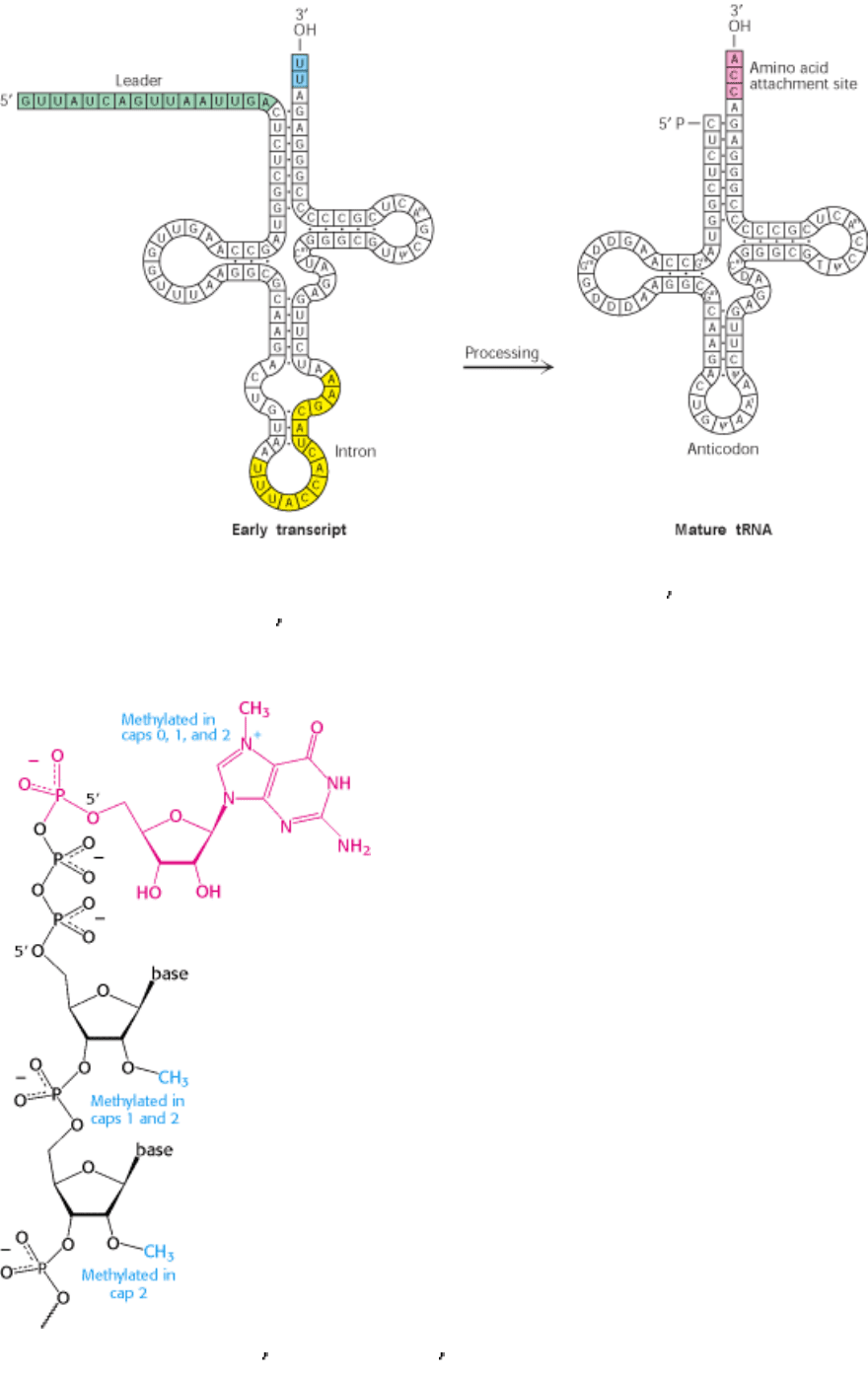
III. Synthesizing the Molecules of Life 28. RNA Synthesis and Splicing 28.3. The Transcription Products of All Three Eukaryotic Polymerases Are Processed
Figure 28.23. Transfer RNA Precursor Processing. The conversion of a yeast tRNA precursor into a mature tRNA
requires the removal of a 14-nucleotide intron (yellow), the cleavage of a 5
leader (green), and the removal of UU and
the attachment of CCA at the 3
end (red). In addition, several bases are modified.
III. Synthesizing the Molecules of Life 28. RNA Synthesis and Splicing 28.3. The Transcription Products of All Three Eukaryotic Polymerases Are Processed
Figure 28.24. Capping the 5
End. Caps at the 5 end of eukaryotic mRNA include 7-methylguanylate (red) attached by

a triphosphate linkage to the ribose at the 5 end. None of the riboses are methylated in cap 0, one is methylated in cap 1,
and both are methylated in cap 2.
III. Synthesizing the Molecules of Life 28. RNA Synthesis and Splicing 28.3. The Transcription Products of All Three Eukaryotic Polymerases Are Processed
Figure 28.25. Polyadenylation of a Primary Transcript. A specific endonuclease cleaves the RNA downstream of
AAUAAA. Poly(A) polymerase then adds about 250 adenylate residues.
III. Synthesizing the Molecules of Life 28. RNA Synthesis and Splicing 28.3. The Transcription Products of All Three Eukaryotic Polymerases Are Processed
Figure 28.26. RNA Editing. Enzyme- catalyzed deamination of a specific cytidine residue in the mRNA for
apolipoprotein B-100 changes a codon for glutamine (CAA) to a stop codon (UAA). Apolipoprotein B-48, a truncated
version of the protein lacking the LDL receptor-binding domain, is generated by this posttranscriptional change in the
mRNA sequence. [After P. Hodges and J. Scott. Trends Biochem. Sci. 17(1992):77.]
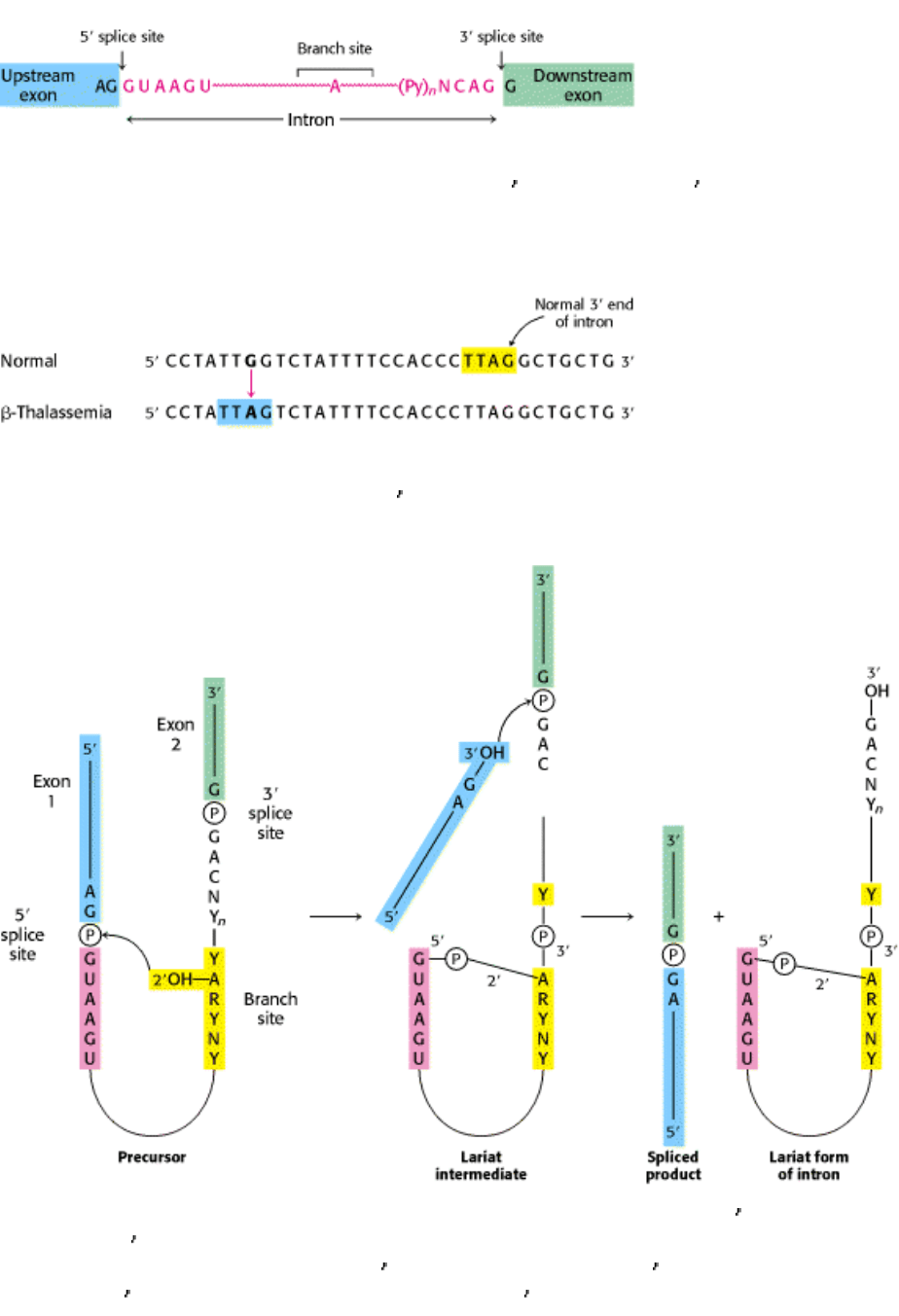
III. Synthesizing the Molecules of Life 28. RNA Synthesis and Splicing 28.3. The Transcription Products of All Three Eukaryotic Polymerases Are Processed
Figure 28.27. Splice Sites. Consensus sequences for the 5
splice site and the 3 splice site are shown. Py stands for
pyrimidine.
III. Synthesizing the Molecules of Life 28. RNA Synthesis and Splicing 28.3. The Transcription Products of All Three Eukaryotic Polymerases Are Processed
Figure 28.28. Splicing Defects. Mutation of a single base (G to A) in an intron of the β-globin gene leads to
thalassemia. This mutation generates a new 3
splice site (blue) akin to the normal one (yellow) but farther upstream.
III. Synthesizing the Molecules of Life 28. RNA Synthesis and Splicing 28.3. The Transcription Products of All Three Eukaryotic Polymerases Are Processed
Figure 28.29. Splicing Mechanism Used for mRNA Precursors. The upstream (5
) exon is shown in blue, the
downstream (3
) exon in green, and the branch site in yellow. Y stands for a purine nucleotide, R for a pyrimidine
nucleotide, and N for any nucleotide. The 5
splice site is attacked by the 2 -OH group of the branch-site adenosine
residue. The 3
splice site is attacked by the newly formed 3 -OH group of the upstream exon. The exons are joined, and
the intron is released in the form of a lariat. [After P. A. Sharp. Cell 2(1985):3980.]
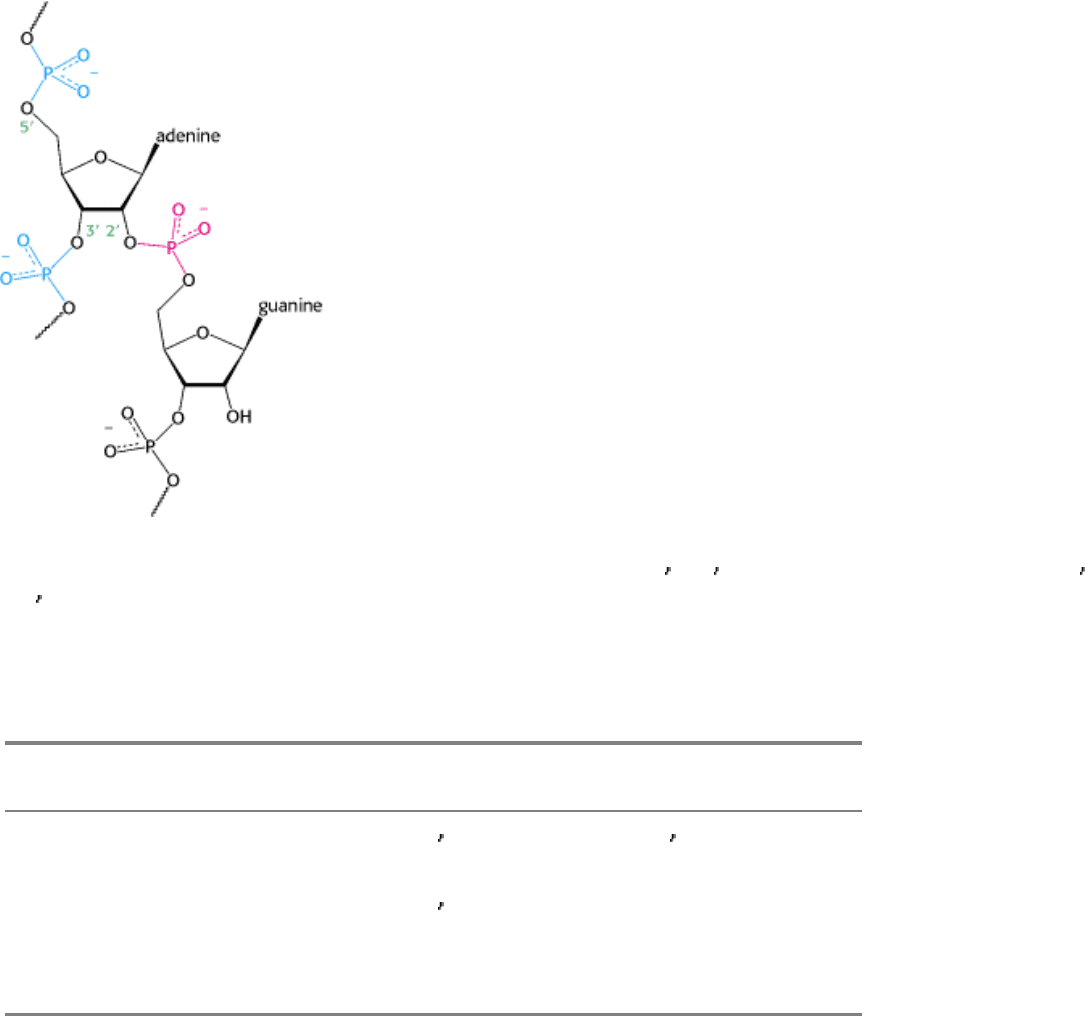
III. Synthesizing the Molecules of Life 28. RNA Synthesis and Splicing 28.3. The Transcription Products of All Three Eukaryotic Polymerases Are Processed
Figure 28.30. Splicing Branch Point. The structure of the branch point in the lariat intermediate in which the adenylate
residue is joined to three nucleotides by phosphodiester bonds. The new 2
-to-5 linkage is shown in red, and the usual 3 -
to-5
linkages are shown in blue.
III. Synthesizing the Molecules of Life 28. RNA Synthesis and Splicing 28.3. The Transcription Products of All Three Eukaryotic Polymerases Are Processed
Table 28.3. Small nuclear ribonucleoprotein particles (snRNPs) in the splicing of mRNA precursors
snRNP Size of snRNA(nucleotides) Role
U1 165 Binds the 5 splice site and then the 3 splice site
U2 185 Binds the branch site and forms part of the catalytic center
U5 116 Binds the 5
splice site
U4 145 Masks the catalytic activity of U6
U6 106 Catalyzes splicing
III. Synthesizing the Molecules of Life 28. RNA Synthesis and Splicing 28.3. The Transcription Products of All Three Eukaryotic Polymerases Are Processed
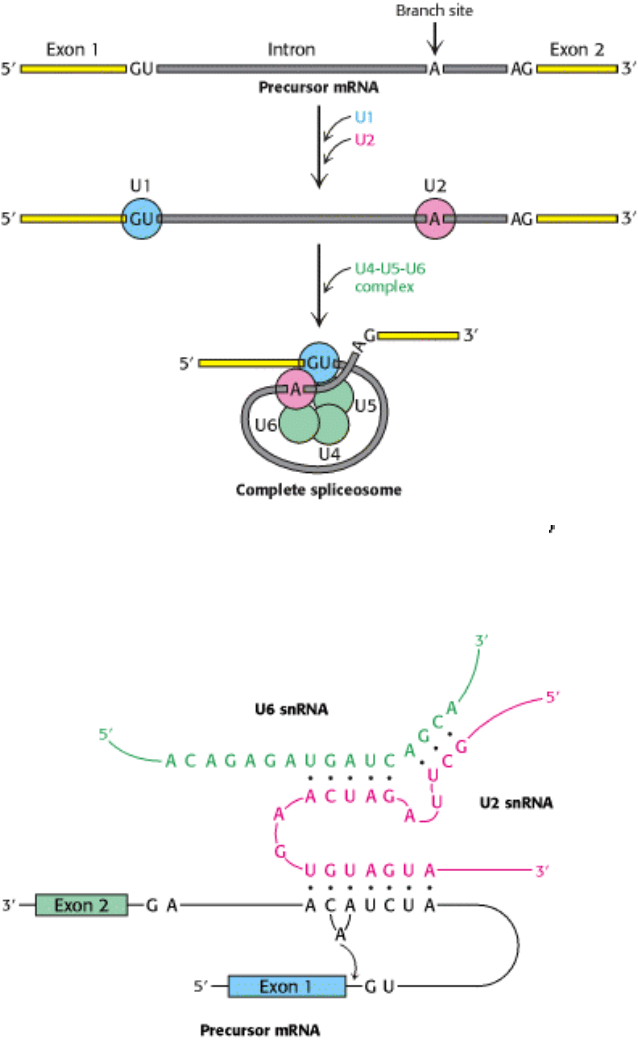
Figure 28.31. Spliceosome Assembly. U1 (blue) binds the 5
splice site and U2 (red) to the branch point. A preformed
U4-U5-U6 complex then joins the assembly to form the complete spliceosome.
III. Synthesizing the Molecules of Life 28. RNA Synthesis and Splicing 28.3. The Transcription Products of All Three Eukaryotic Polymerases Are Processed
Figure 28.32. Splicing Catalytic Center. The catalytic center of the spliceosome is formed by U2 snRNA (red) and U6
snRNA (green), which are base paired. U2 is also base paired to the branch site of the mRNA precursor. [After H. D.
Madhani and C. Guthrie. Cell 71(1992):803.]
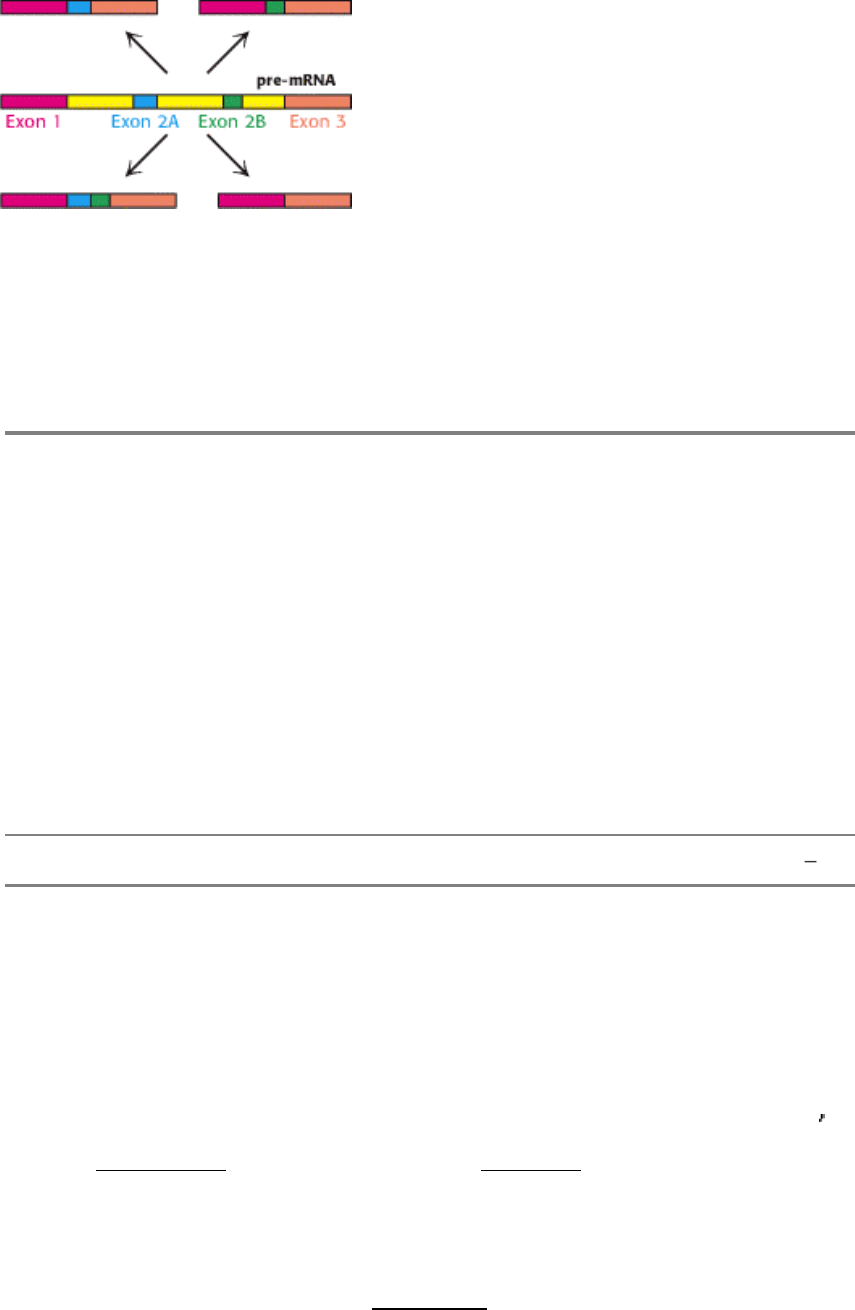
III. Synthesizing the Molecules of Life 28. RNA Synthesis and Splicing 28.3. The Transcription Products of All Three Eukaryotic Polymerases Are Processed
Figure 28.33. Alternative Splicing Patterns. A pre-mRNA with multiple exons is sometimes spliced in different ways.
Here, with two alternative exons (exons 2A and 2B) present, the mRNA can be produced with neither, either, or both
exons included. More complex alternative splicing patterns also are possible.
III. Synthesizing the Molecules of Life 28. RNA Synthesis and Splicing 28.3. The Transcription Products of All Three Eukaryotic Polymerases Are Processed
Table 28.4. Selected proteins exhibiting alternative RNA splicing
Actin
Alcohol dehydrogenase
Aldolase
K-ras
Calcitonin
Fibrinogen
Fibronectin
Myosin
Nerve growth factor
Tropomyosin
Troponin
Source: R. E. Breitbart, A. Andreadis, and B. Nadal-Ginard. Annu. Rev. Biochem. 56(1987):467 495.
III. Synthesizing the Molecules of Life 28. RNA Synthesis and Splicing
28.4. The Discovery of Catalytic RNA Was Revealing in Regard to Both Mechanism
and Evolution
RNAs form a surprisingly versatile class of molecules. As we have seen, splicing is catalyzed largely by RNA
molecules, with proteins playing a secondary role. Another enzyme that contains a key RNA component is ribonuclease
P (RNAse P), which catalyzes the maturation of tRNA by removing nucleotides from the 5
end of the precursor
molecule (Section 28.1.8). Finally, as we shall see in Chapter 29, the RNA component of ribosomes is the catalyst that
carries out protein synthesis.
The versatility of RNA first became clear from observations regarding the processing carried out on ribosomal RNA in a
single-cell eukaryote. In Tetrahymena (a ciliated protozoan), a 414-nucleotide intron is removed from a 6.4-kb precursor
to yield the mature 26S rRNA molecule (Figure 28.34). In an elegant series of studies of this splicing reaction, Thomas
Cech and his coworkers established that the RNA spliced itself to precisely excise the 414-nucleotide intron. These
remarkable experiments demonstrated that an RNA molecule can splice itself in the absence of protein and, indeed, can
have highly specific catalytic activity.

The self-splicing reaction requires an added guanosine nucleotide. Nucleotides were originally included in the reaction
mixture because it was thought that ATP or GTP might be needed as an energy source. Instead, the nucleotides were
found to be necessary as cofactors. The required cofactor proved to be a guanosine unit, in the form of guanosine, GMP,
GDP, or GTP. G (denoting any one of these species) serves not as an energy source but as an attacking group that
becomes transiently incorporated into the RNA (see Figure 28.34). G binds to the RNA and then attacks the 5 splice site
to form a phosphodiester bond with the 5
end of the intron. This transesterification reaction generates a 3 -OH group at
the end of the upstream exon. This newly attached 3
-OH group then attacks the 3 splice. This second transesterification
reaction joins the two exons and leads to the release of the 414-nucleotide intron.
Self-splicing depends on the structural integrity of the rRNA precursor. Much of the intron is needed for self-splicing.
This molecule, like many RNAs, has a folded structure formed by many double-helical stems and loops (Figure 28.35).
Examination of the three-dimensional structure determined by x-ray crystallography reveals a compact folding structure
that is in many ways analogous to the structures of protein enzymes. A welldefined pocket for binding the guanosine is
formed within the structure.
Analysis of the base sequence of the rRNA precursor suggested that the 5
splice site is aligned with the catalytic
residues by base-pairing between a pyrimidine-rich region (CUCUCU) of the upstream exon and a purine-rich guide
sequence (GGGAGG) within the intron (Figure 28.36). The intron brings together the guanosine cofactor and the 5
splice site so that the 3
-OH group of G can nucleophilically attack the phosphorus atom at this splice site. Another part
of the intron then holds the downstream exon in position for attack by the newly formed 3
-OH group of the upstream
exon. A phosphodiester bond is formed between the two exons, and the intron is released as a linear molecule. Like
catalysis by protein enzymes, selfcatalysis of bond formation and breakage in this rRNA precursor is highly specific.
The finding of enzymatic activity in the self-splicing intron and in the RNA component of RNAse P has opened new
areas of inquiry and changed the way in which we think about molecular evolution. The discovery that RNA can be a
catalyst as well as an information carrier suggests that an RNA world may have existed early in the evolution of life,
before the appearance of DNA and protein (Section 2.2.2).
Messenger RNA precursors in the mitochondria of yeast and fungi also undergo self-splicing, as do some RNA
precursors in the chloroplasts of unicellular organisms such as Chlamydomonas. Self-splicing reactions can be classified
according to the nature of the unit that attacks the upstream splice site. Group I self-splicing is mediated by a guanosine
cofactor, as in Tetrahymena. The attacking moiety in group II splicing is the 2
-OH group of a specific adenylate of the
intron (Figure 28.37).
Group I and group II self-splicing resembles spliceosome-catalyzed splicing in two respects. First, in initial step, a ribose
hydroxyl group attacks the 5
splice site. The newly formed 3 -OH terminus of the upstream exon then attacks the 3
splice site to form a phosphodiester bond with the downstream exon. Second, both reactions are transesterifications in
which the phosphate moieties at each splice site are retained in the products. The number of phosphodiester bonds stays
constant. Group II splicing is like the spliceosome-catalyzed splicing of mRNA precursors in several additional ways.
The attack at the 5
splice site is carried out by a part of the intron itself (the 2 -OH group of adenosine) rather than by an
external cofactor (G). In both cases, the intron is released in the form of a lariat. Moreover, in some instances, the group
II intron is transcribed in pieces that assemble through hydrogen bonding to the catalytic intron, in a manner analogous
to the assembly of the snRNAs in the spliceosome.
These similarities have led to the suggestion that the spliceosomecatalyzed splicing of mRNA precursors evolved
from RNA-catalyzed self-splicing. Group II splicing may well be an intermediate between group I splicing and the
splicing in the nuclei of higher eukaryotes. A major step in this transition was the transfer of catalytic power from the
intron itself to other molecules. The formation of spliceosomes gave genes a new freedom because introns were no
longer constrained to provide the catalytic center for splicing. Another advantage of external catalysts for splicing is that
they can be more readily regulated. However, it is important to note that similarities do not establish ancestry. The
similarities between group II introns and mRNA splicing may be a result of convergent evolution. Perhaps there are only
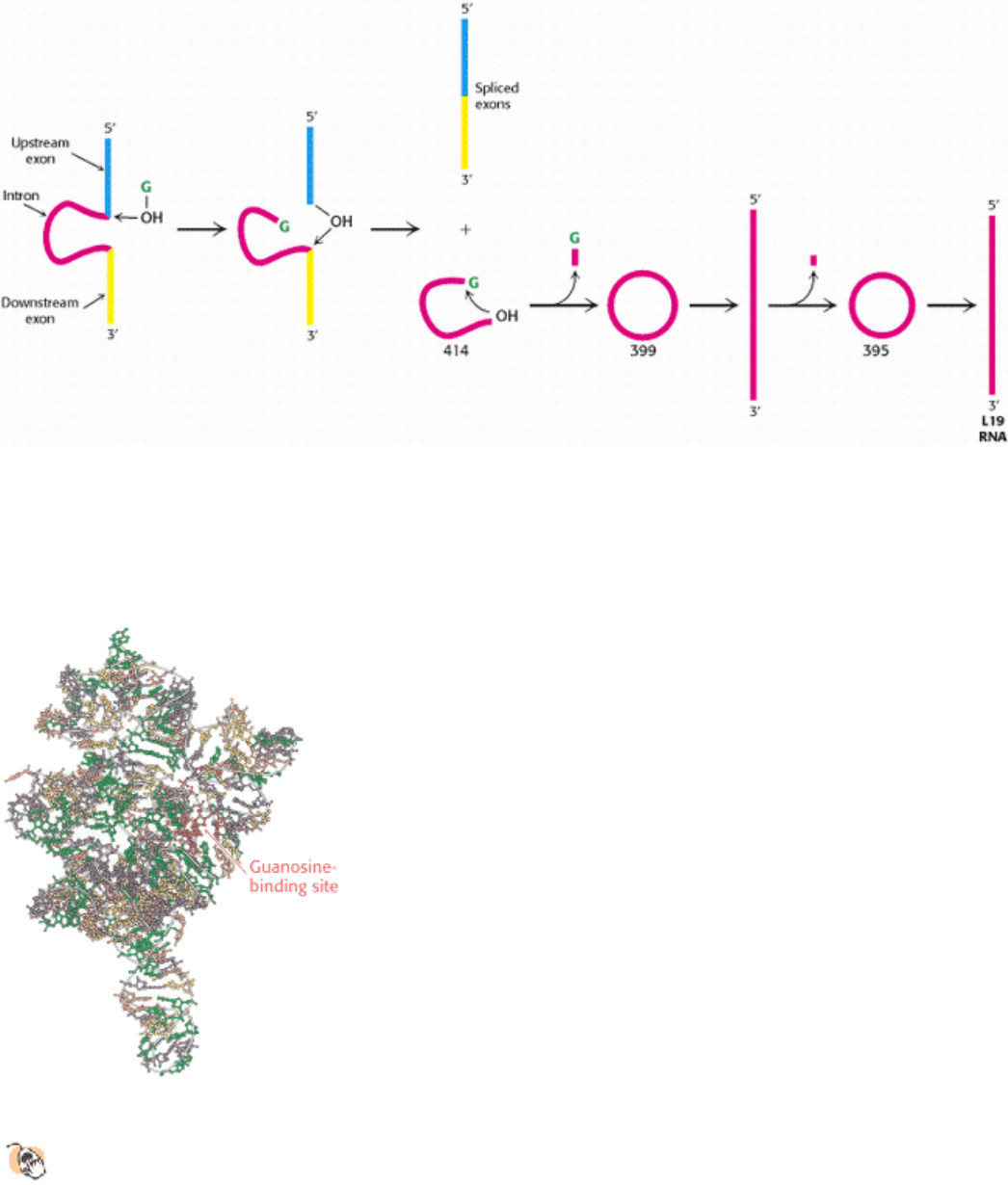
a limited number of ways to carry out efficient, specific intron excision. The determination of whether these similarities
stem from ancestry or from chemistry will require expanding our understanding of RNA biochemistry.
III. Synthesizing the Molecules of Life 28. RNA Synthesis and Splicing 28.4. The Discovery of Catalytic RNA Was Revealing in Regard to Both Mechanism and Evolution
Figure 28.34. Self-Splicing. A ribosomal RNA precursor from Tetrahymena splices itself in the presence of a guanosine
co- factor (G, shown in green). A 414-nucleotide intron (red) is released in the first splicing reaction. This intron then
splices itself twice again to produce a linear RNA that has lost a total of 19 nucleotides. This L19 RNA is catalytically
active. [After T. Cech. RNA as an enzyme. Copyright © 1986 by Scientific American, Inc. All rights reserved.]
III. Synthesizing the Molecules of Life 28. RNA Synthesis and Splicing 28.4. The Discovery of Catalytic RNA Was Revealing in Regard to Both Mechanism and Evolution
Figure 28.35. Structure of a Self-Splicing Intron.
The structure of a large fragment of the self-splicing intron from
Tetrahymena reveals a complex folding pattern of helices and loops. Bases are shown in green, A; yellow, C;
purple, G; and orange, U.
